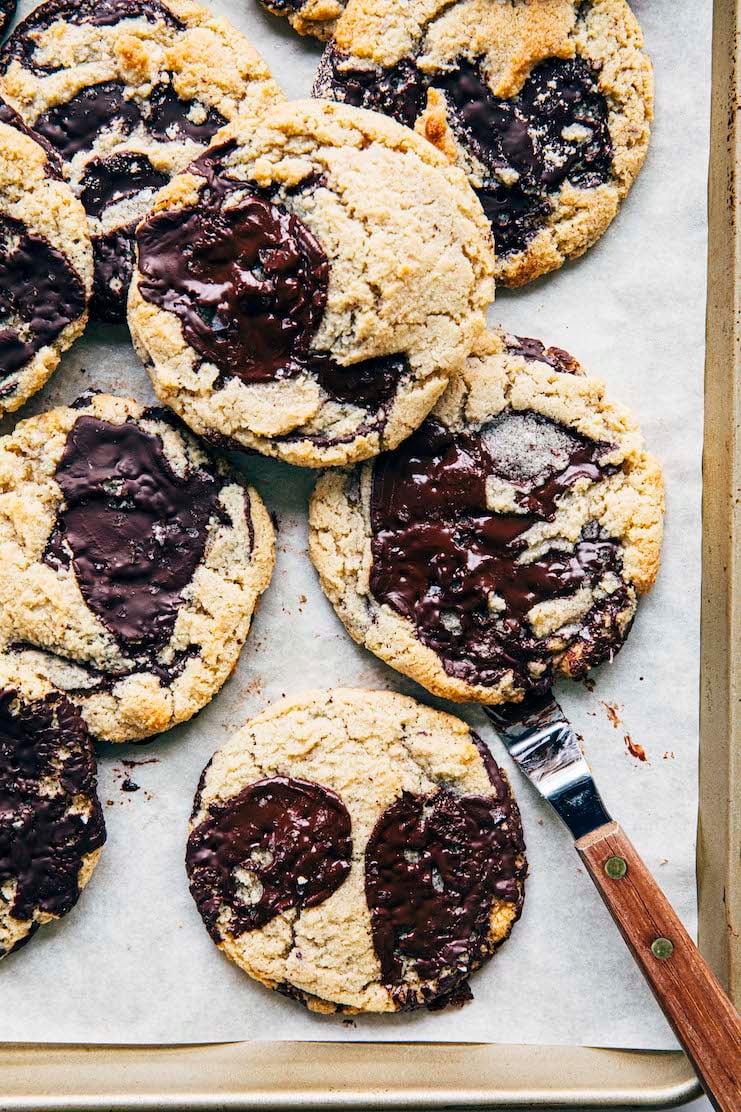
About These Gluten Free Almond Flour Chocolate Chip Cookies
These almond flour chocolate chip cookies use all almond flour, making them 100% gluten free! Despite being gluten free, they look and taste EXACTLY like your favorite chocolate chip cookie with all-purpose flour. Think: cookies with chewy, gooey centers with crispy, lightly browned edges, complete with puddles of melted dark chocolate throughout. The best part? This recipe comes together quickly, with no chilling required!
Are these almond flour chocolate chip cookies gluten free?
Yes! They are 100% gluten free because the recipe uses almond flour (which is a gluten free product).
Are these almond flour chocolate chip cookies vegan?
No. The cookies contain both butter and eggs, which are animal products. However, if you jump to the Ingredients and Substitutions section of the post, I provide some substitutions to make the cookies vegan.
Do these chocolate chip cookies taste like almond?
Yes and no. When fresh and warm out of the oven, the almond flour chocolate chip cookies taste just like regular chocolate chip cookies without any almond products in them. However, as they cool to room temp, the cookies develop a very subtle nutty flavor from the almond flour. This nutty flavor also intensifies overnight.
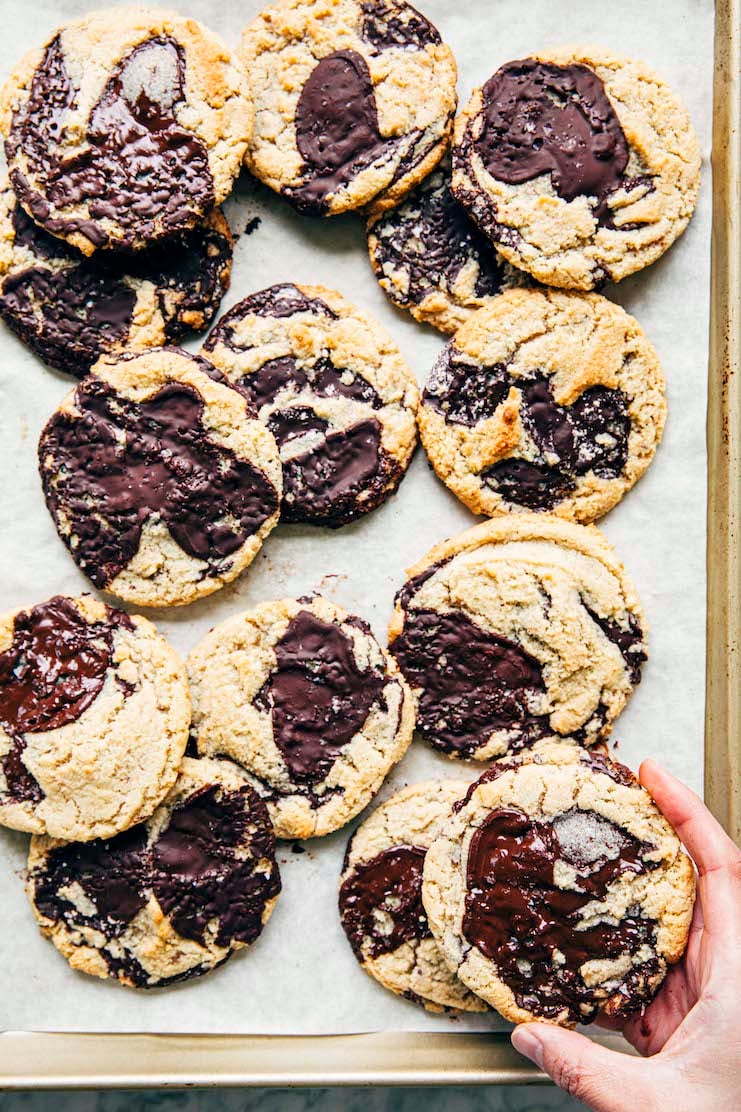
Why You Should Make The Recipe
Here are all the reasons why you should make this almond flour chocolate chip cookie recipe:
This recipe is adapted from New York Times Cooking, and developed by the talented Erin McDowell.
I’ve been wanting to develop an almond chocolate chip cookie recipe for some time now. However, most of the recipes I found online skewed too healthy, resulting in dry and hard cookies. Others used additional obscure flours and ingredients like xanthan gum, which I like to avoid in my baking. I don’t like buying whole bags of ingredients that I only use once or twice and have them languish in my pantry for the rest of the year!
However, as I was scrolling through the saved recipes in my New York Times Cooking account, I saw I’d saved this almond flour chocolate chip cookie recipe. It was developed by my friend Erin McDowell (one of the most talented bakers I know). She’d based it off of one of my favorite chocolate chip cookie recipes ever, Jacques Torres’ chocolate chip cookie (also known as the New York Times chocolate chip cookie, or as I fondly call them 24 Hour, 24 Dollar Chocolate Chip Cookies).
Upon first trying the recipe, I knew I’d found a keeper. Erin’s recipe made delicious AND beautiful almond flour chocolate chip cookies with barely any adjustments needed. The only tweaks I really made were to scale the cookies down from a bakery-style size to a more reasonable homemade one. I also adjusted the Bake Time of the recipe slightly to result in chewier cookies (as opposed to crispier ones).
The almond flour chocolate chip cookies are 100% gluten free but don’t use any specialty ingredients like obscure flours or gums.
One of the things I like best about Erin’s recipe is that it used 100% almond flour (which is a gluten free product), with no other gluten free flours or stabilizers like xanthan gum! No shade to other gluten free flours—although they can be quite flavorful, they require a ton of research and experimentation to work with because they have different properties than all-purpose flour.
While almond flour also has its own distinct properties from all-purpose flour, I use it frequently enough in other recipes (like these Small Batch Almond Flour Brownies! Or these Copycat Levain Bakery Blueberry Muffins!). A bag of almond flour in my pantry wouldn’t languish in the same way that say, a bag of amaranth or coconut flour would.
The almond flour chocolate chip cookies contain butter and eggs, but can easily be made vegan with some substitutions.
Another quality I liked about Erin’s recipe is that, despite using gluten free flour, she still uses conventional butter and eggs. When recipe developers develop gluten free recipes, they tend to cater to ALL dietary restrictions—that usually means eliminating the butter and eggs for vegan options, and maybe even the sugar, too.
But despite many of y’all’s best wishes, I don’t do that here at Hummingbird High. I don’t have any dietary restrictions and don’t shy away from using butter, eggs, and sugar. Still, I get it. Many of you do. So if that’s your jam, I’ve included notes in the Ingredients and Substitutions on how to use vegan stick butter and egg replacers to make this recipe vegan.
The recipe comes together quickly—no chilling of the cookie dough required!
Most fancy chocolate chip cookie recipes instruct their bakers to chill the dough beforehand. And I get it—there’s plenty of science out there that states that, yes, chilling your cookie dough before baking will lead to better flavored cookies.
However, I’m happy to report that these almond flour chocolate chip cookies are PLENTY delicious without needing to be chilled beforehand. To me, that is always a sign of a GREAT chocolate chip cookie recipe.
The almond flour chocolate chip cookies store well, both BEFORE and AFTER baking.
That being said, if you want to chill the cookie dough beforehand, GO FOR IT. It’s true, your cookies will turn out a little bit better—they’ll taste both more almondy AND more butterscotchy. I’ve included instructions on how to freeze and bake the cookies for later. Like most drop cookie recipes, the dough can be frozen for a long time.
And after you’ve finished baking them, the almond flour chocolate chip cookies store really well. The almond flour keeps the cookies moist for days, and overnight, the almond flavors of the cookie intensify. They definitely taste more nutty and complex the day after baking.
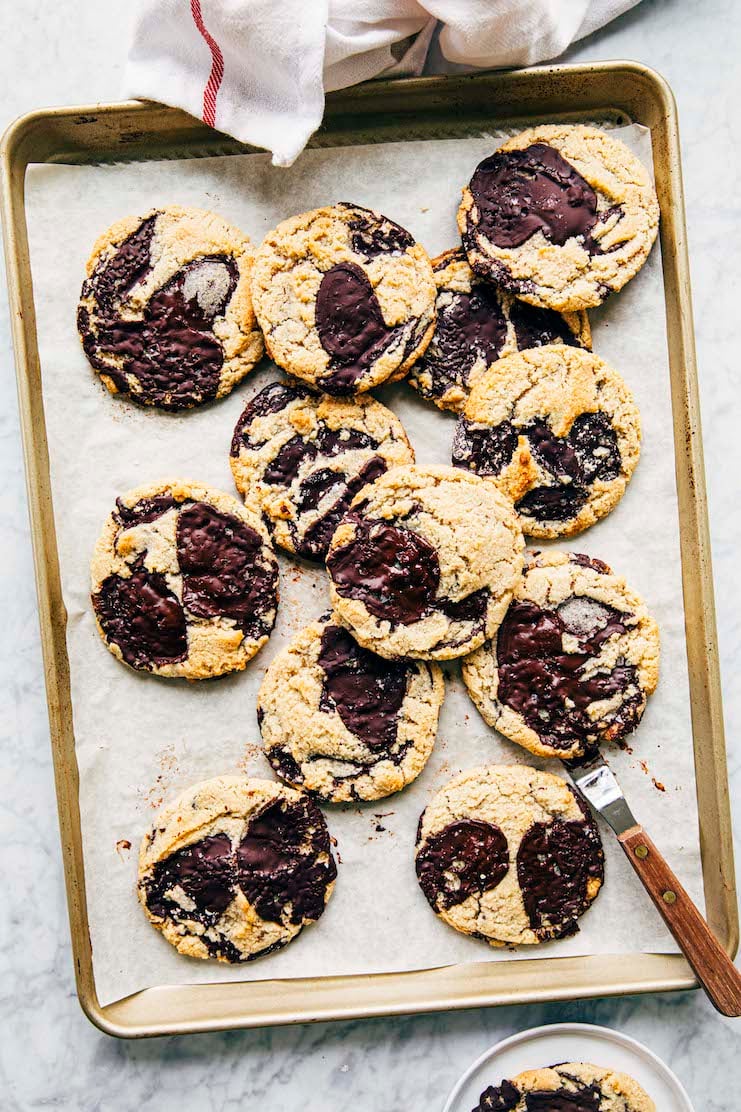
Ingredients and Substitutions
Now that I’ve convinced you to make these almond flour chocolate chip cookies, here’s everything you need for the recipe:
Shopping List for Almond Flour Chocolate Chip Cookies
Be sure to scroll down to the recipe card for the exact ingredient quantities—hit the “Jump to The Recipe” button on the page for a quick shortcut!
- almond flour OR almond meal
- baking soda
- kosher salt
- unsalted butter
- dark OR light brown sugar
- granulated sugar
- large eggs
- pure vanilla extract
- dark chocolate (between 60% to 70% cacao), from whole fèves or a high-quality chocolate bar
And let’s talk about some key ingredients and any potential substitutions:
Almond Flour
You need 2 ¾ cups almond flour or almond meal to make these almond flour chocolate chip cookies.
What is almond flour?
Almond flour is a “flour” made from finely ground almonds. I use quotation marks around the word “flour” because almond flour technically isn’t flour. Most flours are made from milling different types of wheat. But not almond flour!
Is almond flour gluten free?
Yes! Almond flour is typically used in gluten free baking since it contains no gluten.
Is almond meal the same as almond flour?
Okay, TL/DR: almond meal and almond flour are the same thing.
Some folks will argue with you and say that almond flour is made with blanched almonds. Blanching the almonds removes their skins, giving you a consistent pale yellowish white almond flour. Almond meal, on the other hand, are made with almonds that haven’t been blanched. As a result, almond meal contains almond skin and is dark brown and speckled in color.
But real talk: manufacturers don’t have any formal rules to follow when it comes to defining their labels as almond flour versus almond meal. Although there are some manufacturers—like Bob’s Red Mill—who do a great job of sticking to that definition above, there are many others who don’t. That’s why you’ll see almond flour labelled as “almond meal”, and vice versa. So don’t stress about it too much.
And what does it mean for these almond flour chocolate chip cookies? You can use either almond meal or almond flour in the recipe, no problem.
What about blanched almond meal? What is blanched almond meal anyway? And what about blanched almond flour?
Ah, yes. To make matters even more confusing, some manufacturers like to call their almond flour “blanched almond meal” or “blanched almond flour.” Both describes almond flour that’s been made with blanched almonds, resulting in the pale, yellowish white almond flour.
Can you substitute almond flour for regular flour?
Sort of. Contrary to what diet blogs tell you, you cannot substitute regular all-purpose flour with almond flour 1:1. Why? They’re made from completely different things. I mentioned earlier that most flour is made from milled wheat, while almond flour is made from, well, almonds (duh).
As a result, almond flour has way more fat than wheat flour. It also absorbs liquid differently. And bakers need to account for these different qualities by adjusting other ingredients in the recipe accordingly.
Where To Buy Almond Flour
Back in the day, almond flour used to be a rarity and typically only available in fancy grocery stores and hippie food co-ops. But now, most major supermarkets carry the stuff.
Looking for a brand recommendation? My favorite almond flour is from Bob’s Red Mill (who sells both almond flour and almond meal—see my essay about the differences between the two above, lol). I also like King Arthur Baking Company’s almond flour.
How To Make Almond Flour
Alright, you proved me wrong. You could not find any almond flour at any store. No worries! You can make it at home, too.
To make almond flour at home, pulse raw almonds in a food processor until finely ground. That’s it! Be careful not to overprocess the nuts—you might accidentally end up with almond butter, lol. Instead, pulse the nuts for 2 to 3 seconds at a time until you get the texture of a coarse meal.
Butter
You need 10 Tablespoons unsalted butter to make these almond flour chocolate chip cookies.
I don’t have unsalted butter. Can I use salted butter instead?
Absolutely! However, I recommend reducing the recipe’s salt quantity from 1 teaspoon to ¾ teaspoon instead.
Can I use a vegan stick butter like Earth Balance or Miyoko’s instead?
Yes, with reservations. Crawling through the New York Times Cooking comment section, it looks like many people successfully replaced the butter in the recipe with a vegan stick alternative. However, I haven’t personally tried it myself, so I can’t guarantee the results.
Brown Sugar
You need ½ cup tightly packed dark OR light brown sugar to make these almond flour chocolate chip cookies.
Light versus Dark Brown Sugar
Brown sugar is granulated white sugar with a touch of molasses to give it its signature color and flavor. Because brown sugar contains molasses, it adds more moisture baked goods than granulated sugar otherwise would.
Brown sugar is available in two varieties: light or dark. Dark brown sugar is my personal preference; because it contains more molasses, I find it to be more flavorful. However, you can use either in this recipe without altering its flavor too much.
I don’t have brown sugar. Can I use ALL granulated sugar instead?
Sadly, no. At least, not if you want your cookies to look and taste like mine. Why? The molasses in the brown sugar makes brown sugar more acidic than granulated white sugar. This acidic nature makes it react better with baking soda (which is alkaline in nature), the primary leavener in this recipe.
Leaveners are the ingredients in baking recipes that responsible for making the baked goods rise. They do so by reacting with other ingredients to create bubbles in batters and doughs. The reaction is usually activated when an acidic ingredient is mixed an alkaline ingredient, and/or the heat from the oven.
Because granulated sugar isn’t acidic in the same way, it won’t react with the baking soda as effectively as brown sugar. What does that mean for your cookies? If you use ALL white sugar in this recipe, you’ll likely have cookies that will spread and rise in unpredictable ways. It might still be tasty, but I can’t wholeheartedly recommend it.
Can I use coconut sugar instead of brown sugar?
Sadly, no. In the answer above this question, I wrote that granulated sugar isn’t acidic in the same way as brown sugar. That acidity is what helps activate the baking soda, giving the cookies their texture and shape.
Although coconut sugar is frequently used as a substitute for brown sugar, it won’t work in this recipe. Coconut sugar is more similar to granulated sugar in terms of acidity—it won’t react with baking soda as effectively as brown sugar.
What does that mean for your cookies? If you use coconut sugar instead of brown sugar this recipe, you’ll likely have cookies that will spread and rise in unpredictable ways. It might still be tasty, but I can’t wholeheartedly recommend it.
Dark Chocolate
You need 2 cups dark chocolate (between 60% to 70% cacao), from whole fèves or a high-quality chocolate bar, to make these almond flour chocolate chip cookies.
Check out my post on The Best Chocolate For Chocolate Chip Cookies, which discusses why you should use dark chocolate with cacao percentages, chopped chocolate from baking bars and/or fèves, and more when making chocolate chip cookies!
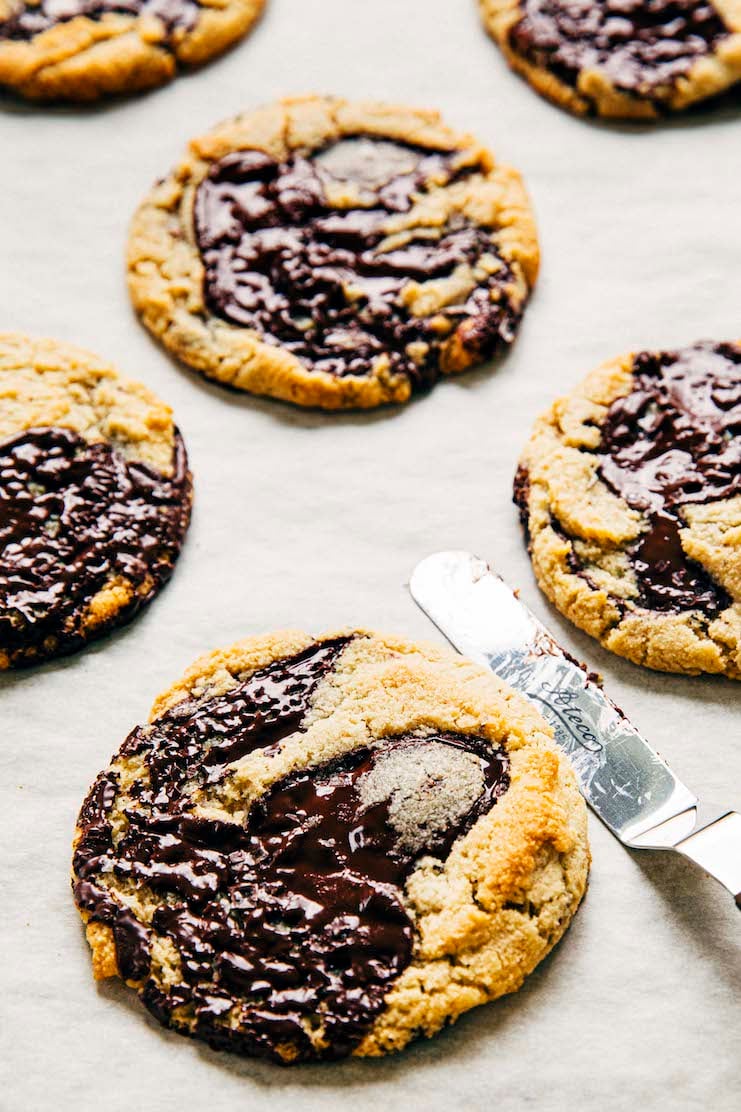
How To Make The Recipe
Here are the basic steps to make almond flour chocolate chip cookies from scratch:
- Prep the ingredients for the cookies. (Prep Time: 5 to 10 minutes)
The prep process for these almond flour chocolate chip cookies is easy! All you need to do is measure out the ingredients beforehand. That’s it! If you’re using whole fèves like I recommended, there’s no need to chop them up beforehand. As a result, your prep time will only be about 5 minutes. However, if you’re chopping up chocolate for the recipe, your prep time will be 10 minutes. - Then, make the cookie dough. (Work Time: 10 minutes)
The dough comes together quickly. First, mix the dry ingredients in a small bowl. Then, beat the butter and sugars until creamy and fluffy. Then, add the egg and vanilla. Finally mix in the dry ingredients, then the chocolate. That’s it! - Next, assemble the cookies. (Work Time: 5 minutes)
The fastest and easiest way to make picture-perfect cookies is to invest in a cookie dough scoop. These handy tools scoop the dough into dough balls that bake into perfect cookie circles every time. In general, I use a 3-Tablespoon or 4-Tablespoon sized cookie dough scoops to make my cookie recipes. Doing so makes perfect 3- to 3.5-inch wide cookies. - Finally, bake the cookies. (Bake Time: 15 minutes)
The almond flour chocolate chip cookies need 15 minutes in the oven. When done, the edges should be set. However, the centers will still look a little soft. That’s normal! In fact, that’s the secret to a perfect cookie with a chewy center.
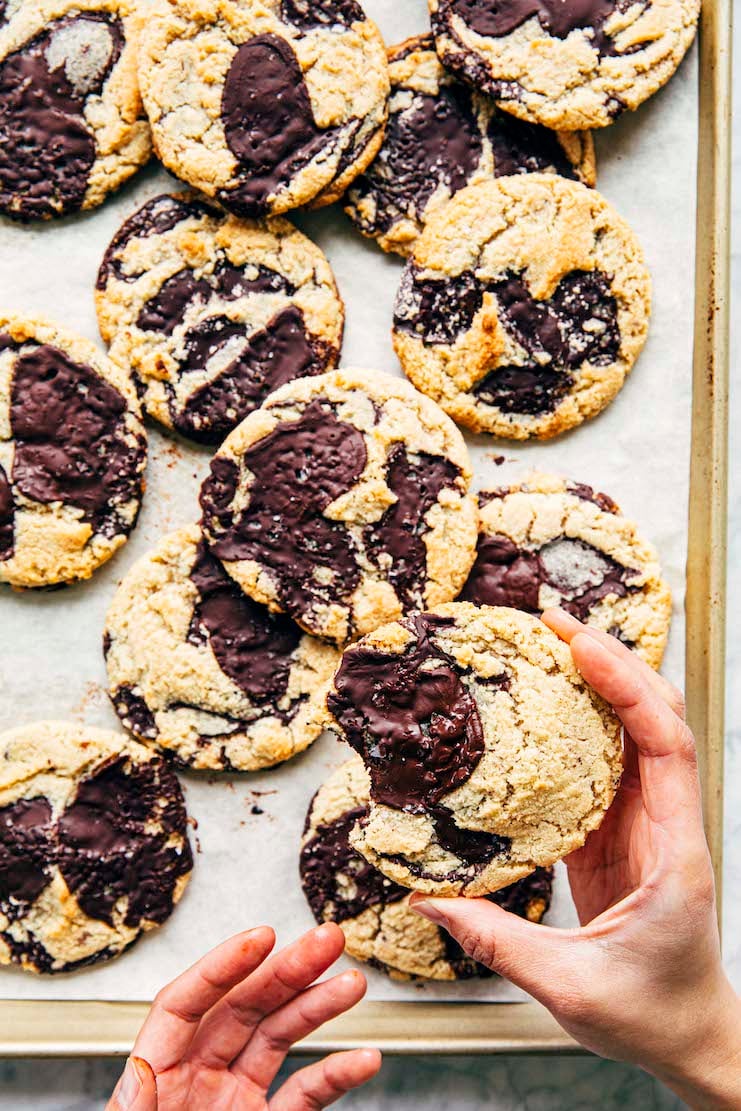
Recipe Troubleshooting and FAQ
FAQ: Baking Tools To Make This Recipe
What baking tools do I need to make almond flour chocolate chip cookies?
To make the recipe, I recommend the following baking equipment:
- half sheet pans (I used 3 half sheet pans when making my cookies.)
- parchment paper (I like the kind that lays flat, like these ones from King Arthur Baking.)
- a stand mixer with a paddle attachment
- a rubber spatula
- a 4-Tablespoon cookie dough scoop (You can also use a 3-Tablespoon cookie dough scoop, which results in slightly smaller cookies and is actually my preferred size for cookies. But for these cookies, I ran an Instagram poll on my Stories and found that y’all wanted them to be a little bigger!)
- a wire rack
Can I use a handheld electric mixer instead of a stand mixer?
Yes! For all my recipes, unless I explicitly state otherwise, you can always use a handheld electric mixer instead of a stand mixer. Just note that handheld mixers are less powerful than stand mixer. You may need to add 1 to 2 minutes of extra mixing time to what’s stated in the recipe.
FAQ: Troubleshooting Unexpected Results
Help! My cookies came out too puffy. They didn’t sink after baking and don’t look flat like yours. What did I do wrong?
Okay, there are several things that could be responsible for overly puffy cookies:
You didn’t measure the ingredients properly.
If you used cup measures as opposed to weight measures, there’s a larger chance your cookies will come out puffy.
There’s a LOT of variation in how people use measuring cups. Somebody who scoops ingredients into a measuring cup and packs it down as they go will have a cup that has way more ingredients than somebody who simply scoops the flour into a cup and levels it off as its filled. This is why bakers love measuring by weight with a digital scale instead—it’s much more reliable and completely eliminates any inconsistencies!
While these variations aren’t a big deal for many recipes, they can be a big deal for cookies. Specifically: if you pack a heavy cup of flour, your cookies will come out too puffy. They won’t fall and sink in the same way as mine did.
So to fill a measuring cup properly, you need to first set the measuring cup on a flat, level surface like your kitchen counter. Spoon the ingredient into the measuring cup until it forms a small mound within the cup. Use a butter knife or bench scraper to level off the mound so that the ingredient is flush with the top edges of the measuring cup.
Finally, if you’re measuring a dry ingredient that has a tendency to clump or get packed down (like flour, confectioners’ sugar, or cocoa powder), give it a quick whisk in its container first. Then, scoop the ingredient into the measuring cup as I described.
You deliberately (or accidentally!) reduced the sugar in the recipe.
Many people often deliberately reduce the sugar in baking recipes for health reasons, or for fear of the recipe being “too sweet.” But the fact is that sugar is in baking recipes for reasons beyond flavor and sweetness! In baking, sugar helps baked good spread evenly and consistently. It also adds moisture and color to the baked goods. If you went this route, it’s likely that your cookies will stay puffy and taste drier than mine.
But how do you accidentally reduce the sugar in the recipe? Similar to how you accidentally use too much flour in a recipe—by failing to use measuring cups and spoons properly. Read my instructions in the question above on how to scoop and fill a measuring cup the right way.
You used chocolate chips instead of fèves or chopped chocolate.
Chocolate chips are made with stabilizers like more cocoa solids and paraffin wax (yes, the kind of wax candles are made out of) to ensure that they keep their shape when baked. They tend to stay 3-dimensional, leading to a puffy cookie that doesn’t fall flat.
You are baking chilled cookie dough but didn’t thaw the dough slightly beforehand.
In the FAQ section below, I give you options to freeze your cookie dough for baking later. However, note that you’ll need to thaw the cookie dough slightly when baking from frozen.
What does that mean? Simply set the cookie dough out on a lined sheet pan (the same one you’re planning on baking the cookies on!) as the oven preheats. It usually takes about 10 to 15 minutes for most ovens to preheat. The 10 to 15 minutes out at room temperature will allow the cookie dough to thaw slightly and bake up nicely in the oven. If you skip this thaw, your cookies will come out puffy!
Help! I made these almond flour chocolate chip cookies but they don’t look like your cookies. My chocolate stayed mostly in tact. They didn’t melt and pool throughout the cookie like yours did. What did I do wrong?
First things first: did you use chocolate chips? If you did, they’re the likely culprit.
I mentioned earlier that chocolate chips are made with stabilizers like more cocoa solids and paraffin wax to ensure that they keep their shape when baked. They won’t melt and pool into puddles like chopped chocolate bars. That’s why I always recommend using chopped chocolate if you’re looking for a picture-perfect, Instagram-ready cookie!
However, if you did use chopped chocolate, it’s likely that you chopped your chocolate up too finely. You want to keep the pieces fairly big—think: ½ inch to 1 inch pieces. Bigger pieces will get more melty and molten!
Finally, if you’re using feves, note that some fèves melt better than others—milk and white chocolate doesn’t melt as well as dark chocolate, and Valrhona dark chocolate fèves melt better than Guittard wafers. If you want your cookies to look EXACTLY like mine, I recommend buying Valrhona Caraïbe fèves.
FAQ: Storing Almond Flour Chocolate Chip Cookies
How To Store Almond Flour Chocolate Chip Cookies
After baking, the cookies can be stored in an airtight container or zip-top bag at room temperature for up to 3 days.
Can you freeze almond flour chocolate chip cookies?
Yes! You can freeze almond flour chocolate chip cookies in the following ways:
- Freeze the UNBAKED almond flour chocolate chip cookie dough.
Follow the recipe instructions to make the cookie dough and scoop them out into cookie dough balls. Place the cookie dough balls in a small sheet pan. Cover the pan with plastic wrap and freeze for at least 1 hour, or until the cookie dough balls are frozen solid. Transfer the cookie dough balls to a zip-top bag and freeze for up to 1 year.
To bake the frozen cookie dough balls, line sheet pans with parchment paper and position the cookie dough balls at least 3 inches apart on the sheet pans. Then, follow the recipe instructions to preheat the oven. Bake for 16 to 18 minutes, or until the edges have set but the centers are still gooey. - Freeze the BAKED almond flour chocolate chip cookies.
Individually wrap any leftover chocolate chip cookies in two layers of plastic wrap, then a layer of aluminum foil. The aluminum foil will prevent the cookies from absorbing any other flavors or odors in the freezer. When ready to serve, transfer to the refrigerator to chill overnight. Rewarm in the microwave or in the oven at 350°F for 5 minutes before serving.
Best Almond Flour Chocolate Chip Cookie Recipe Tips
Styling Tip
- Want your cookies to look *EXACTLY* like mine, with a signature puddle of melted chocolate skimmed across each surface? Easy! Simply reserve a fève or a ½- to 1-inch piece of chopped chocolate for each cookie. Place on top of each cookie dough ball before baking. The chocolate will melt into the puddles you see on top of each cookie!
Best Baking Tips
- I like to bake the cookies one pan at a time. I find that doing so makes the best cookies, ensuring that none of them have overly burnt bottoms or raw centers. However, to save time, you can bake two sheet pans at a time. Position a rack in the upper-third position of the oven, and a second one in the lower-third position of the oven. Bake a pan on each rack, swapping their positions half way through the Bake Time.
- When done, the cookies will look ever-so-slightly toasted—they should have just a *touch* of golden brown, but will be fairly pale otherwise. That’s normal! Almond flour doesn’t brown in the same way as all-purpose flour.
More Gluten Free Recipes
- 3 Ingredient Peanut Butter Cookies
- Cassava Cake
- Chaffle Recipe
- Flourless Chocolate Cookies
- Flourless Gluten Free Cheesecake Brownies
- Small Batch Almond Flour Brownies
- Small Batch Baked Ube Mochi Donuts
More Chocolate Chip Cookie Recipes
- Chocolate Chip Cookie Cake Recipe
- Chocolate Chip Cookies With Powdered Sugar
- M&M Cookies
- Oatmeal Chocolate Chip Cookie Recipe
- NOT Cakey Pumpkin Chocolate Chip Cookies
- Small Batch Chocolate Chip Cookies
- Toll House Chocolate Chip Cookie Recipe, Elevated
- Vegan Tahini Chocolate Chip Cookies
Get the Recipe: Gluten Free Almond Flour Chocolate Chip Cookies Recipe
Ingredients
- 2 ¾ cups (10.95 ounces or 310 grams) almond flour OR almond meal
- ½ teaspoon baking soda
- 1 teaspoon kosher salt
- 10 Tablespoons (1 ¼ sticks OR 5 ounces OR 140 grams) unsalted butter, at room temperature
- ½ cup tightly packed (3.75 ounces or 106 grams) dark OR light brown sugar
- ½ cup (3.5 ounces or 99 grams) granulated sugar
- 1 large egg, at room temperature
- 1 ½ teaspoons pure vanilla extract
- 2 cups (12 ounces or 340 grams) dark chocolate (between 60% to 70% cacao), from whole fèves or a high-quality chocolate bar chopped into ½- and 1-inch pieces
- flaky salt, for garnish
Equipment
- a (4-Tablespoon) cookie dough scoop
Instructions
- Prep the oven and baking pans. Position a rack in the center of the oven and preheat the oven to 350°F. Line two half sheet pans with parchment paper.
- Mix the dry ingredients. In a medium bowl, whisk together the almond flour, baking soda, and salt.
- Cream the butter and sugar, then add the egg and vanilla. In the bowl of a stand mixer fitted with the paddle attachment, combine the butter and sugars. Beat on medium-high until light, fluffy, and doubled in volume, 2 to 3 minutes, using a rubber spatula to scrape down the bottom and sides of the bowl as necessary. Reduce the mixer to low, add the egg and vanilla, and beat until combined. Scrape down bottom and sides of the bowl.
- Add the dry ingredients, then the chocolate. With the mixer on low, gradually add the dry ingredients and beat until just combined. Add the chocolate all at once and beat on medium-low until the chocolate is evenly distributed throughout, about 1 minute.
- Assemble the cookies. Use a 4-Tablespoon cookie dough scoop to portion the cookie dough into balls, placing them at least 3 inches apart on the prepared sheet pans.
- Bake the cookies. Bake one pan at a time for 15 minutes, or until the edges have set but the centers are still gooey. Cool the cookies on the pan on a wire rack for 20 minutes, or until the edges and bottoms of the cookies have set and feel firm to the touch. Repeat with the remaining cookie dough.
- Serve and store. Serve warm or at room temperature. The cookies can be stored in an airtight container or zip-top bag at room temperature for up to 3 days.
Notes
- Want your cookies to look *EXACTLY* like mine, with a signature puddle of melted chocolate skimmed across each surface? Easy! Simply reserve a fève or a ½- to 1-inch piece of chopped chocolate for each cookie. Place on top of each cookie dough ball before baking. The chocolate will melt into the puddles you see on top of each cookie!
- I like to bake the cookies one pan at a time. I find that doing so makes the best cookies, ensuring that none of them have overly burnt bottoms or raw centers. However, to save time, you can bake two sheet pans at a time. Position a rack in the upper-third position of the oven, and a second one in the lower-third position of the oven. Bake a pan on each rack, swapping their positions half way through the Bake Time.
- When done, the cookies will look ever-so-slightly toasted—they should have just a *touch* of golden brown, but will be fairly pale otherwise. That’s normal! Almond flour doesn’t brown in the same way as all-purpose flour.
Did you make this recipe?
Please leave a comment and rating for the recipe using the form below!
Your ratings make it easier to find the recipe online, and I’m always looking for ways to improve Hummingbird High.

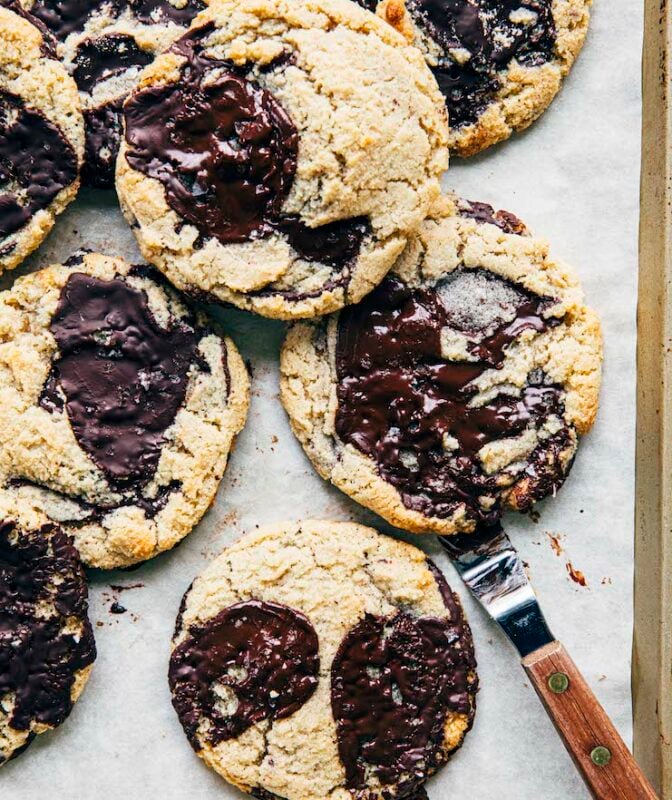
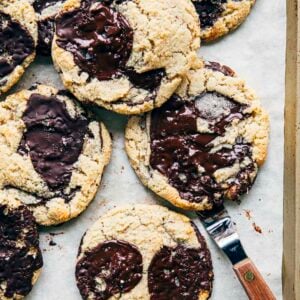


I love these cookies! I used the fine Italian sea salt I have on hand which worked just fine. It was totally worth it too to get a 4 tbsp scoop for these. The only odd observation is that when I measured the almond flour in grams, I could tell it was far more than 2.75 cups. So I went with cups rather than grams.
This recipe was wonderful! They freeze really well.